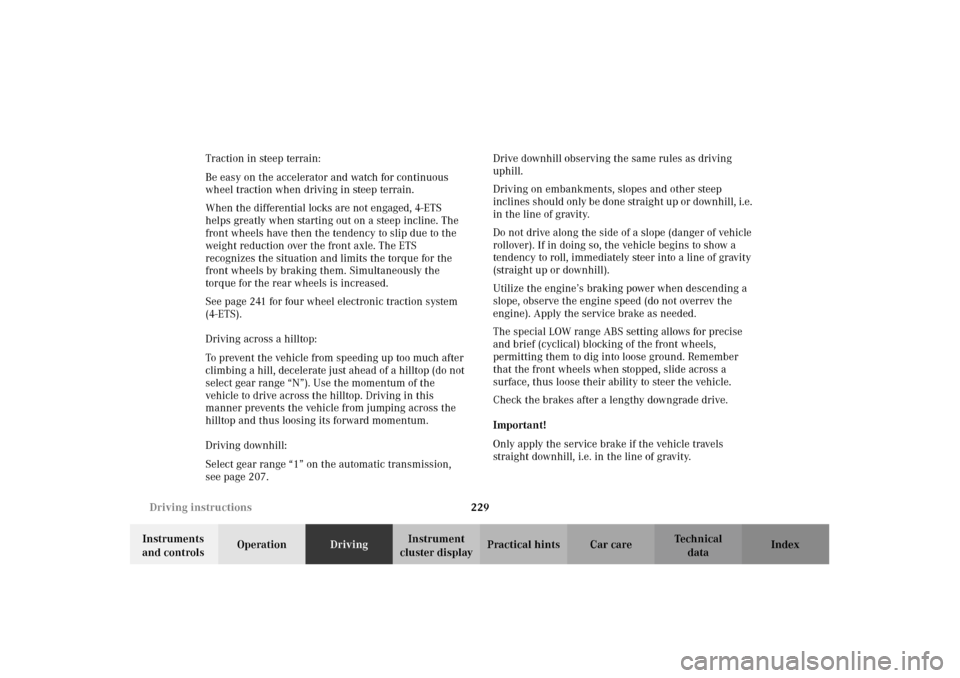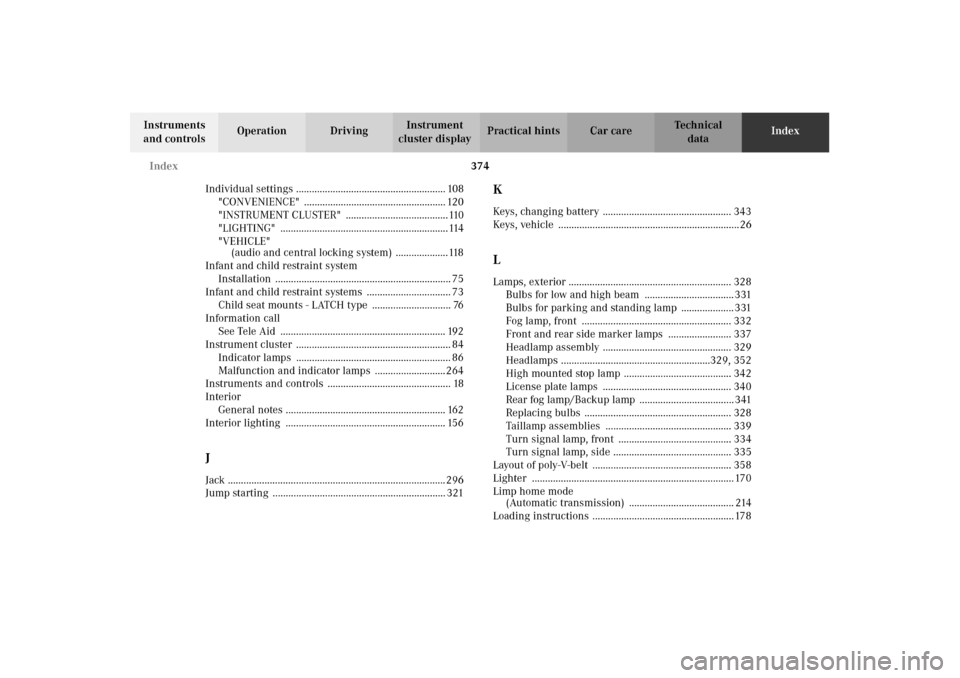Page 232 of 385

229 Driving instructions
Te ch n i c a l
data Instruments
and controlsOperationDrivingInstrument
cluster displayPractical hints Car care Index Traction in steep terrain:
Be easy on the accelerator and watch for continuous
wheel traction when driving in steep terrain.
When the differential locks are not engaged, 4-ETS
helps greatly when starting out on a steep incline. The
front wheels have then the tendency to slip due to the
weight reduction over the front axle. The ETS
recognizes the situation and limits the torque for the
front wheels by braking them. Simultaneously the
torque for the rear wheels is increased.
See page 241 for four wheel electronic traction system
(4-ETS).
Driving across a hilltop:
To prevent the vehicle from speeding up too much after
climbing a hill, decelerate just ahead of a hilltop (do not
select gear range “N”). Use the momentum of the
vehicle to drive across the hilltop. Driving in this
manner prevents the vehicle from jumping across the
hilltop and thus loosing its forward momentum.
Driving downhill:
Select gear range “1” on the automatic transmission,
see page 207.Drive downhill observing the same rules as driving
uphill.
Driving on embankments, slopes and other steep
inclines should only be done straight up or downhill, i.e.
in the line of gravity.
Do not drive along the side of a slope (danger of vehicle
rollover). If in doing so, the vehicle begins to show a
tendency to roll, immediately steer into a line of gravity
(straight up or downhill).
Utilize the engine’s braking power when descending a
slope, observe the engine speed (do not overrev the
engine). Apply the service brake as needed.
The special LOW range ABS setting allows for precise
and brief (cyclical) blocking of the front wheels,
permitting them to dig into loose ground. Remember
that the front wheels when stopped, slide across a
surface, thus loose their ability to steer the vehicle.
Check the brakes after a lengthy downgrade drive.
Important!
Only apply the service brake if the vehicle travels
straight downhill, i.e. in the line of gravity.
J_G463.book Seite 229 Mittwoch, 19. September 2001 8:06 08
Page 233 of 385
230 Driving instructions
Te ch n i c a l
data Instruments
and controlsOperationDrivingInstrument
cluster displayPractical hints Car care Index
Driving through water
120 in (50 cm)
Before driving through water, determine its depth. It
should not be deeper than approximately
20 inches (50 cm).Switch the transfer case in position LOW before driving
through water.
If necessary activate differential locks, see page 253.
ABS, BAS and ESP are switched off automatically when
the differential locks are activated.
Switch off the exterior lamps as well as the climate
control.
Enter the water only at a shallow spot. Never take a
running start. Drive slowly, avoiding a bow wave.
Do not stop vehicle immersed in water, and do not shut
off the engine.
To dry the brakes, apply pressure to the brake pedal
several times after leaving the water.
J_G463.book Seite 230 Mittwoch, 19. September 2001 8:06 08
Page 377 of 385

374 Index
Te ch n i c a l
data Instruments
and controlsOperation DrivingInstrument
cluster displayPractical hints Car careIndex
Individual settings ......................................................... 108
"CONVENIENCE" ...................................................... 120
"INSTRUMENT CLUSTER" .......................................110
"LIGHTING" ................................................................114
"VEHICLE"
(audio and central locking system) ....................118
Infant and child restraint system
Installation ................................................................... 75
Infant and child restraint systems ................................ 73
Child seat mounts - LATCH type .............................. 76
Information call
See Tele Aid ............................................................... 192
Instrument cluster ........................................................... 84
Indicator lamps ........................................................... 86
Malfunction and indicator lamps ...........................264
Instruments and controls ............................................... 18
Interior
General notes ............................................................. 162
Interior lighting ............................................................. 156
JJack ................................................................................... 296
Jump starting .................................................................. 321
KKeys, changing battery ................................................. 343
Keys, vehicle .....................................................................26LLamps, exterior .............................................................. 328
Bulbs for low and high beam .................................. 331
Bulbs for parking and standing lamp .................... 331
Fog lamp, front ......................................................... 332
Front and rear side marker lamps ........................ 337
Headlamp assembly ................................................. 329
Headlamps .........................................................329, 352
High mounted stop lamp ......................................... 342
License plate lamps ................................................. 340
Rear fog lamp/Backup lamp .................................... 341
Replacing bulbs ........................................................ 328
Taillamp assemblies ................................................ 339
Turn signal lamp, front ........................................... 334
Turn signal lamp, side ............................................. 335
Layout of poly-V-belt ..................................................... 358
Lighter ............................................................................. 170
Limp home mode
(Automatic transmission) ........................................ 214
Loading instructions ...................................................... 178
J_G463.book Seite 374 Mittwoch, 19. September 2001 8:06 08